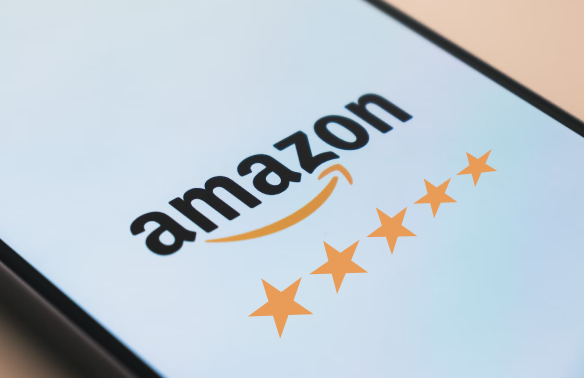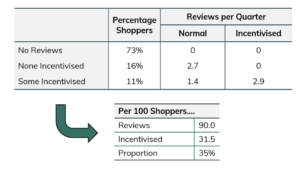Incentivised Reviews: Are Fake Amazon Reviews a Problem?
Posted: 26/09/2022


It is said that fake Amazon reviews are a problem. It is said that 93% of people check these reviews before they make a purchase and that a positive review increases sales by about 20%. It is said that less principled retailers will pay up to $100 for a fake review. So, what proportion of Amazon reviews are in fact “incentivised” and what are the implications for consumer protection?
Prevalence Rate
To explore this problem in more detail, we ran some fieldwork to measure how often people left reviews and what proportion of those reviews were in exchange for some form of compensation. Figure 1 contains a summary of the findings. About 27% of the population left a review on Amazon over the past 3 months and, on average, they left 3.4 reviews, or about one per month. 42% of these people, 11% of the total population, received an incentive. These incentives covered about two-thirds of their Amazon posts.
Figure 1: Review Volumes

Source: Decision Technology fieldwork and modelling (n = 1,327 Nat Rep)
The conclusion is that around 35% of Amazon reviews are incentivised. To many this will seem like a staggering number. But it’s actually on the low side of the existing consensus. For example, Fakespot – a browser add-on that uses AI to identify fake posts – estimates the proportion of incentivised reviews at 42%. And other people’s estimates range higher. But Fakespot themselves are incentivised, as are pretty much everyone except Amazon, to exaggerate these estimates.
Perhaps our number is an under-estimate because people were too embarrassed to tell us the truth? Not so. Using a research method called Unmatched Count Technique to anonymise people’s responses, we found that the underlying incidence rate for incentivised reviews is, if anything, lower than our estimate here. People actively boast about getting paid to post stuff on Amazon when asked.
Are We Bothered?
But even if 35% is lower than generally believed, it’s hardly a good look. And to be fair, Amazon have made efforts to address the problem. However, by our calculation, there’s around 7m new Amazon reviews per week in the US alone. It’s a non-trivial task to identify and remove 400k fake reviews every day. Certainly, that process can’t involve any meaningful manual intervention. It may, in fact, be nearly impossible in practice.
So how much are consumers out of pocket from this type of fraud? Let’s stick with the US where Amazon turnover was $314Bn in 2021. And let’s assume the reported 20% uplift in purchase propensity is accurate. It certainly seems realistic based on our experience. Then, combined with the 35% fake review prevalence, Amazon’s sales are 7% higher due to fake reviews, equivalent to about $22Bn of additional sales per year.
One side note is that, given a 30% gross margin, those additional sales are worth about $7Bn to Amazon retailers. This works out at $17 per fake review. It would be irrational for a retailer to pay above this on average for a fake review. Hence the going rate for a fake review must be in the $10 range.
Looking at this from the consumer side, the relevant lens is Price Elasticity of Demand. This figure, the ratio of percent volume change to percent price change, is typically in the x3.0 range for consumer goods1. Hence, a 7.0% volume increase would otherwise require a 2.3% price cut. In effect, consumers would normally charge $7Bn for the purchase behaviours being generated by fake reviews. So that’s how much they are out of pocket.
That seems like a substantial social cost to pay. Or to put it another way, is Amazon spending $7Bn per year to remove these fake reviews? And if it isn’t, shouldn’t the regulator charge them an equivalent amount for the pollution?
1. Consistent with the 30% margin assumption if the market is in equilibrium. It’s not a coincidence that both costs are $7Bn.